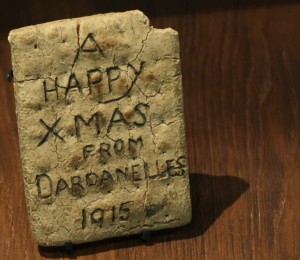
A HAPPY XMAS FROM DARDANELLES 1915
Army biscuit, Imperial War Museum, London.
(P. Ferguson image, September 2017)
A Christmas Dardanelles Army Biscuit
The four inch square number 4 Army standard biscuit, and other known varieties, were hard as a rock, made of whole wheat flour and lacked nutrients. The mostly loathed biscuit was produced during the Great War by British firms such as Huntley & Palmers, based in Reading. The biscuit could be a challenge to a soldier’s dental work but soldiers, being an inventive and resourceful lot, managed to find creative uses to allow the biscuits to pass for palatable by soaking them in tea or water. Or alternatively, by turning them into picture frames, canvases, postcards and message boards. Some of these army issued refashioned biscuits became the subject of a 2015 exhibition produced by the Reading Museum and The Museum of English Rural Life. See “The First World War in Biscuits”.
Huntley and Palmer was founded in 1822 and became equally known, apart from their biscuits and cakes for their fine decorative and prized tins. During the Great War not only did they produce No. 4s and seemingly Nos. 1- 5, 9 and 10, but they also converted their tin shops to the production of cases for artillery shells. See: Huntley and Palmers tins. The firm, The Most Famous Biscuit Company in the World continued in the biscuits and cakes trade until 1976 but has recently returned to operations.
Huntley and Palmers Great War biscuits were impressed with the lettering “Huntley & / ARMY No. 4 / PALMERS”. Presumably other varieties include different numbers and other manufacturers.
Tags: 1915, Christmas, Dardanelles, Huntley and Palmers, Imperial War Museum, Reading
This entry was posted by pferguson
on Monday, December 21st, 2020 at 10:18 pm and is filed under Christmas Special, Snapshots of the Great War.
You can follow any responses to this entry through the RSS 2.0 feed.
You can leave a response, or trackback from your own site.
About The Author

Paul has worked with the Paradigm Motion Picture Company since 2009 as producer, historian and research specialist. Paul first met Casey and Ian WIlliams of Paradigm in April 2007 at Ieper (Ypres), Belgium when ceremonies were being held for the re-dedication of the Vimy Memorial, France.
Paul's sensitivity to film was developed at an early age seeing his first films at RCAF Zweibrucken, Germany and Sardinia. Paul returned to Canada in 1967 and was captivated by David Lean's "Lawrence of Arabia" and "Bridge on the River Kwai". Over time Paul became increasingly interested in storytelling, content development, character, direction, cinematography, narration and soundtracks.
At the University of Victoria, Paul studied and compared Japanese and Australian film and became interested in Australian film maker Peter Weir and his film "Gallipoli" (1981). Paul was inspired when he learned Weir visited the beaches, ridges and ravines of the peninsula. "Gallipoli", the film, led Paul on many journeys to sites of conflict in England, France, Belgium, Holland, Germany, Malta, Hawaii, Gallipoli, North Macedonia and Salonika.
When Paul first watched documentary filmmaker Ken Burns, "The Civil War", Paul understood how his own experience and insight could be effective and perhaps influential in film-making. Combining his knowledge of Museums and Archives, exhibitions and idea strategies with his film interests was a natural progression.
Paul thinks like a film-maker. His passion for history and storytelling brings to Paradigm an eye (and ear) to the keen and sensitive interests of; content development, the understanding of successful and relational use of collections, imagery and voice. Like Paul's favorite actor, Peter O'Toole, Paul believes in the adage “To deepen not broaden.”
While on this path Paul always remembers his grandmother whose father did not return from the Great War and how his loss shaped her life and how her experience continues to guide him.


Comments